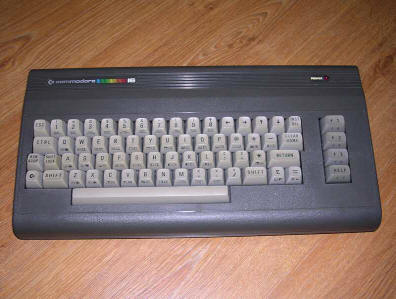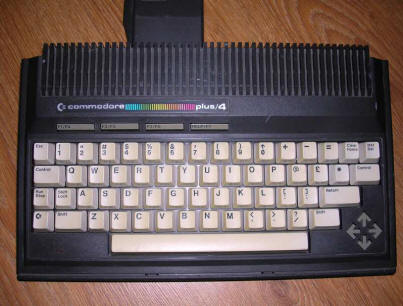Commodore 16 (C16)
Commodore 64 was popular. But comparing to last
manufactured VIC-20s it was a really high end machine. To make
transition from VIC to C64 easier, Commodore designed a 264 line, with
some capabilities lower than in C64 (and some higher).
There were 3 main computers of this line: C116, C16 and C16/Plus4, this
last one with all bells and whistles.
Not so long after introduction the truth came out: By paying a little
more you could have a C64, much better micro with growing software
library, bigger expansion possibilities (User port) and a family of
peripherals. 264s sold poorly and after its flaw in US, they were dumped
to Europe. It wasn't a good idea - users in Europe already started with
C64, and 264 were not compatible with C64. A few schools in Poland
bought it from Hungary to compare with C64s, and after tests decided to
use 64s. C16s were a bit more popular in Hungary, where Commodore tried
to unload it, but they sold as terribly as in US.
Summing up, it was a big marketing failure, and not many users decided
to buy it.
| Manufacturer | Commodore Business Machines | |
| Origin | U.S.A | |
| Year of unit | 1985 | |
| Year of introduction | 1984 | |
| End of production | 1989 ?? | |
| CPU | MOS 7501 (6502-compatible) | |
| Speed | 0.89MHz (PAL) | |
| RAM | 16kB, upgradeable to 64K | |
| ROM | 32kB (Basic) | |
| Colors: | 121 (15x8 + black) | |
| Sound: | 2-channel chip | |
| OS: | Commodore BASIC | |
| Display modes: | Text: 40x25 Graphics: many, best 320x200. |
|
| Media: |
Tape recorder External 5.25" floppy disk drive Cartridge slot |
|
|
Power supply: |
||
|
A female DC Jack on the computer (10V may be used, but it''ll make a little more heat)
|
||
| I/O: | Serial Tape connector Monitor connector Cartridge port RF Modulator 2 Joystick ports |
|
| Possible upgrades: | A few, memory to 64K | |
| Software accessibility: | Quite Easy (TOSEC, sites, servers) |
I know about 2 versions of Commodore 16. The only
difference is in mainboard and joystick connectors - if your C16 has
them labeled JOY 0 and JOY 1, it's earlier than one with JOY 1 and JOY 2
labels.
The first thing we can see inside is a very small mainboard - it looks
like engineers designed it to Plus/4 case, not a breadbox. If they could
use a small switching PSU, it would fit in there without heat problems.
Commodore 16 Plus/4
OK, Commodore 16 was a cheap version of a better
computer - C16/Plus4. Early known as Commodore 264, Plus 4 has 64K of
memory, a smaller case with quite modern keyboard, and 4 productivity
applications built in ROM, giving integrated office system: A word
processor, spreadsheet, graph generator and database. Because these
programs need space, Commodore introduced 1551 - a special faster floppy
disk drive connected to Plus/4 user port (contrary to C16, Plus/4 has
one). With these specs Commodore Plus/4 had an opportunity to become a
popular home and office computer.
But truth was cruel: Plus/4 was another Commodore's Failure. It had 64K,
but with small software library it was hard to use it in a
productive way. Keyboard was more ergonomic and finally used separate
arrows, but inside it was a rubber membrane, wearing out after a year of
use.
The built in software was worth less than its ROM chip. Word processor,
which can edit only 100 lines of text in 40-column mode, a 17x50 cells
spreadsheet, slow as hell, slower than existing spreadsheets for VIC,
graph generator... using text mode, while good graphic modes left unused,
and database: With 999 records maximum, and field limits. The new floppy
drive was indeed faster than serial based drives, but not so fast to
outrun C64 with its turbo/parallel modes.
Finally Commodore tried to sell C264s in Hungary without success. A few
Polish schools bought it to try teaching office applications (Apple
Macintosh with its beautiful productivity suites was much more expensive
and harder to get), but they weren't used after seeing their real
capabilities.
In first units with early mainboard revisions, Commodore added two more
sockets to mainboard with 3 ROM chips. Maybe they hoped that someone
will write something better than their "office applications"?
| Manufacturer | Commodore Business Machines | |
| Origin | U.S.A | |
| Year of unit | 1986 | |
| Year of introduction | 1984 | |
| End of production | 1989 ?? | |
| CPU | MOS 7501 (6502-compatible) | |
| Speed | 0.89MHz (PAL) | |
| RAM | 16kB, upgradeable to 64K | |
| ROM | 64kB (Basic + applications) | |
| Colors: | 121 (15x8 + black) | |
| Sound: | 2-channel chip | |
| OS: | Commodore BASIC, applications | |
| Display modes: | Text: 40x25 Graphics: many, best 320x200. |
|
| Media: |
Tape recorder External 5.25" floppy disk drive Cartridge slot |
|
|
Power supply: |
||
|
A square DIN female on the computer (Commodore 64 power supply with adapter will work) |
||
| I/O: | Serial User port Tape connector Monitor connector Cartridge port RF Modulator 2 Joystick ports |
|
| Possible upgrades: | Using expansion ports | |
| Software accessibility: | Quite Easy (TOSEC, sites, servers) | Accessories in collection: |
There were a few prototype models of this computer:
- Commodore 232 - Its mainboard was closer to C16, with 32K of RAM.
- Commodore 264 - Much like Plus/4, but Commodore claimed that they'll let
customer decide what programs will be embedded to his unit - Current
Plus/4 set, Easycalc 264 (spreadsheet), Financial Advisor, Logo, Pilot,
SuperScript word processor or Magic Desk office suite. Unfortunately
Plus/4 suite was probably the worst option
- Commodore V364 - 264 with numeric keypad, extended software and
expandable speech synthesizer.
| Contents: | Starting | Image file formats | Links |
Starting:
It just boots to BASIC or to cartridge program, if
cartridge is installed, but C64s cartridges are NOT compatible. From
Basic you can load programs in a similar way that in C64.
Commodore 64 peripherals are much compatible with C16, but you have to
make adapters for them. Use pinouts, accessible here:

(it's in Hungarian plus my translation, I don't speak Hungarian at all,
so don't trust it in 100%)
Video (monitor) connector is the same as in C64 - and
C64 monitor cable will work (tested with 3-wire cable).
And one more thing - if your computer has this fancy square connector,
don't expect that you'll buy a plug in a DIY shop on the corner. They
are very rare plugs, so you can cannibalize an old C128 / early Amiga
power supply or re-solder a normal DIN socket in PCB, if you won't
destroy it.
Plus/4 has an integrated monitor program called TEDMON.
How to run Plus/4 software? These are exceprts from manual (Page 33):
" Your Plus/4 is equipped with built-in software
packages. These are programs built into Plus/4, turned on by pressing
the appropriate FUNCTION key. (...)
Enter TEDMON by typing:
MONITOR
TEDMON responds by displaying the 6502 registers and flashing the cursor."
To start a word processor: In BASIC, press F1. A SYS
number will pop up. Then hit RETURN. You'll get word processor and a
whole "office system".
To start a spreadsheet, start a word processor, then hit Commodore-C. W>
will show up. Type tc and press Return.
To start a database, the command is tf.
To go back to word processor, use tw.
To generate graph from spreadsheet, use map command, it's more
quirky (look at Plus/4 Integrated Software Manual)
Image file formats:
They use the same file types that C64 uses. Recording is done in a
similar way, but:
1. It's not possible to easily connect Commodore 1551 disk drive to PC,
use 1541 instead. 1551 uses parallel system bus interface, so to talk to
it, our PC would have to mimic a whole C16 system!
2. Use appropriate timing options when recording tapes and generating
tape images! With C64s timings IT WILL NOT WORK.
Links:
http://plus4world.powweb.com/
- Plus/4 site
http://web.archive.org/web/20140104160705/http://commodore16.com/ -
Before it turned into a blog, it was an excellent dedicated site, in
which you could download manuals for Commodore 16. Now it;s possible to
get some e-books, but it's hard to find anything and it seems that
Gamebase is seriously gone.
http://yape.plus4.net/ - C16
emulator? Why not?
http://c16.c64games.de/ - GERMAN -
Games for C16
http://web.archive.org/web/20120401083456/http://www.cbm264.com/ -
There were many programs, articles and resources (just look thru the
archive). English GEOS in fileland.
http://www.commodore.ca/products/264/Commodore_264_family.htm - Good
article about 264's hardware
http://www.zimmers.net/cbmpics/cv364.html - A Commodore 364
prototype page.






